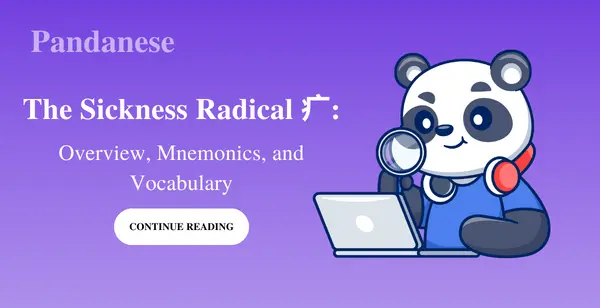
The Sickness Radical 疒: Overview, Mnemonics, and Vocabulary
Welcome back to the Pandanese blog series on radicals!
This series is to help our readers develop their Chinese language skills by getting familiar with the most commonly used Chinese radicals.
Learning radicals can help you accelerate your vocabulary learning and expand your Hanzi knowledge in no time.
In this article, we’ll introduce to you to the radical sickness 疒(nè) and teach you how to memorize its associated vocabulary more effectively.
Let’s jump right in!
What is the sickness radical in Chinese?

The Chinese radical 疒(nè) refers to disease, illness, or sickness. You can find 526 characters (out of 49,030) containing this radical in the Kangxi Dictionary, the most authoritative dictionary of Chinese characters from the 18th century through the early 20th.
Be aware of your pronunciation
You should pay extra attention to your pronunciation of the sickness radical since many new Chinese-language learners often mistakenly say it as 呢 (ne), which is actually a common question Chinese participle that is used to ask reciprocal questions such as ‘’And you?’ or “What about you?”
The sickness radical 疒(nè) has the fourth Chinese tone, and 呢 (ne) has a neutral tone.
What is the stroke order of the 疒 radical?
The sickness radical is composed of five strokes in total. When writing this radical, remember to follow this specific stroke order:

Sickness Chinese radical stroke order
How can you memorize the sickness radical quickly?
You can memorize the Chinese sickness radical by using mnemonics! Here one for you: Doesn't the sickness radical look like a sideways bed with legs? When you're sick, you should lie in bed and take the day off!
The sickness radical and the sickness character are the same. To memorize the Chinese sickness character, try this mnemonic: I was diagnosed with a minor ailment, where I basically experienced sickness (疒) everywhere on my body except for one (一) place. I was throwing up so much into a box (冂) today at work that a man (人) entered (入) my cubicle to see what was wrong with me.
If you want more Chinese mnemonics to help you memorize Chinese Hanzi, try using Pandanese! It is a web-based software that combines mnemonics with SRS to effectively have you learn and review Chinese vocabulary at your own pace.
Sickness radical vocabulary list for you!
Chinese characters (Hanzi) and words using the sickness radical often have meanings associated with sickness and illness.
Character |
Pinyin |
English meaning |
疤 |
bā |
scar |
瘫 |
tān |
paralyzed |
病 |
bìng |
sick |
痛 |
tòng |
pain |
疗 |
liáo |
treatment |
症 |
zhèng |
disease |
痒 |
yǎng |
itch |
痴 |
chī |
crazy |
癌 |
ái |
cancer |
嫉 |
jí |
jealous |
疲 |
pí |
tired |
疫 |
yì |
epidemic |
瘦 |
shòu |
thin |
看病 |
kànbìng |
see a doctor |
病毒 |
bìngdú |
virus |
In closing
Knowing the Chinese sickness radical lets you break down complex Chinese characters. If you see 疒 radical, it will give you some insight into the meaning that is related to sickness, medicine, and health.
The easiest way to learn Chinese & build vocabulary

